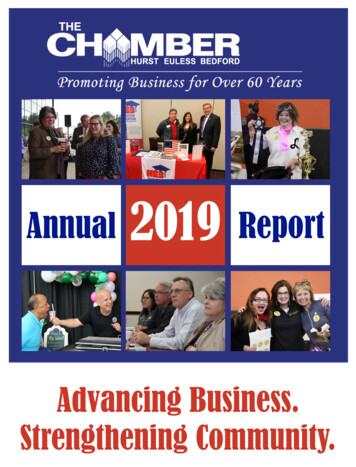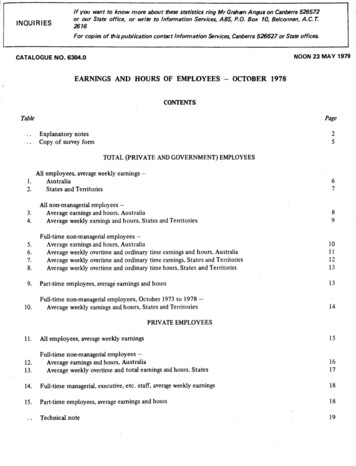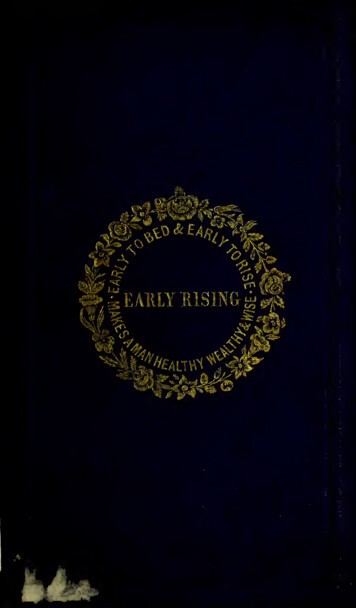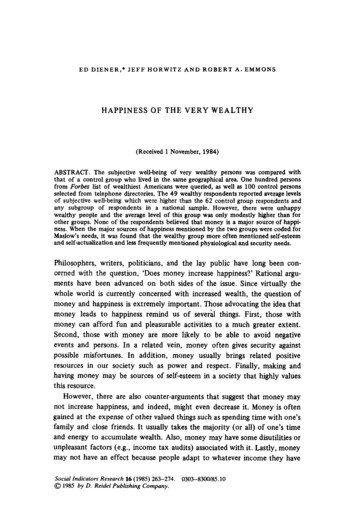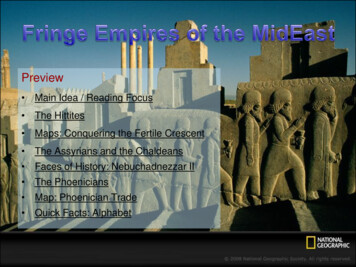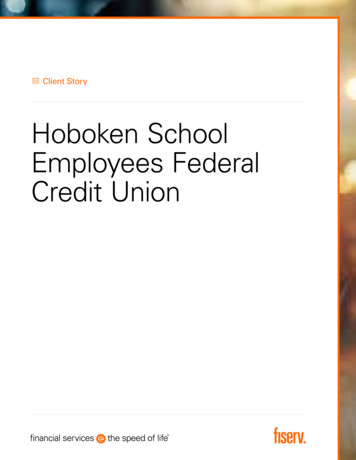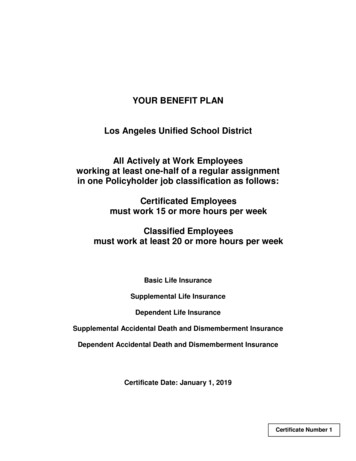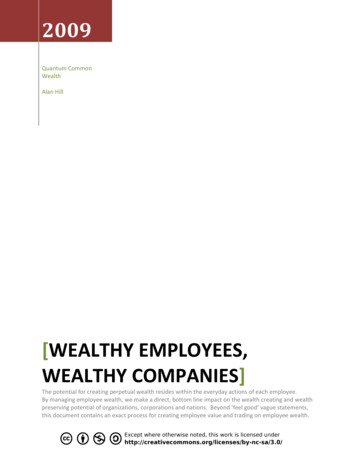
Transcription
2009Quantum CommonWealthAlan Hill[WEALTHY EMPLOYEES,WEALTHY COMPANIES]The potential for creating perpetual wealth resides within the everyday actions of each employee.By managing employee wealth, we make a direct, bottom line impact on the wealth creating and wealthpreserving potential of organizations, corporations and nations. Beyond ‘feel good’ vague statements,this document contains an exact process for creating employee value and trading on employee wealth.
Wealth Creating EmployeesYour employees are priceless – unfortunately no one knows how much, yetAre your employees creating value you’re missing?As a business owner or executive, you may feel your employees are doing a lot to help your companygrow, producing effort beyond their regular job duties. One of the challenges is how to understand andencourage more of that behavior, so that it happens regularly and so employees appreciate their valueand contribution to everyone’s success. After all, a healthy, growing company means work stability foreveryone you employ or manage.“Our Product Engineer saved our company frombankruptcy – he re-engineered a product andstopped a major client from switching to ourcompetition.”Tom S. – Owner, biomed companyAs leaders, we continually challenge ourselves to do more for our team and for our customers.Unfortunately, we can fall short of doing everything we wish for to make everyone successful. The causeof this unfortunate circumstance is not because of the economy, even if we’re facing the challenges ofpending layoffs.Nor is it because we’re bad leaders and managers. Actually, we’re doing the best we can with themanagement tools we’ve been given. Leadership today is laboring under outmoded systems and toolsfrom an industrial era. Our approaches to create inspiration and employee worth are in conflict withsystems designed to keep employees attached to manufacturing equipment. We have advancedtechnology, processes, and information access, but not the tools of leadership.For example, an 8 hour shift schedule was important for manufacturing employees, because if they werenot where they needed to be on the production line, at the exact time they needed to be there,production stopped. It’s not that way in any professional office today, yet we still have the managementtool of an 8 hour shift. As new millennium leaders, it’s time to ask ourselves ‘what tools do we need toquit using, and what new tools do we need to create to lead us into the next age of productivity?”2Wealthy Employees, Wealthy Companies Alan Hill, Quantum Common Wealth
“Our payroll clerk saved us thousands of dollarsin potential fines and fees. She caught a softwareglitch in garnishments during a major softwareupgrade. I’m so grateful.”Ronald P. –CFO, manufacturing companyThe End Of Do More With LessAs leaders, we would like to do more for our customers, our employees and our communities. When thetension between the drive for efficiency versus growth meets head-on, the resulting ‘snap-back’ cancatch us in a bind we didn’t expect and were unable to plan for. It’s challenging to remember theintention was to do good for everyone when the economy contracts around us, leaving us a strangeemotional mixture of frustration and hopeful resignation.If you’ve felt like this as a leader, it can be compounded when your team and employees look to you forsolutions, comfort and guidance right at the point when you seem to be fresh out of the very energy andenthusiasm you know is needed most. In times like these, we may feel it’s all we can do to keep ourspirits up, let alone keep everyone else working toward the same goal.Which leads us to an important revelation; Why do employees look to leaders for answers in times ofcrisis? Why don’t employees look to each other to provide the very answers they seek? After all, we’rerelying on employees to be productive, why don’t we as leaders expect them to provide for companygrowth?Common wisdom in leadership schools says company growth is the responsibility of the leaders. Thetruth is, the growth of the company is directly tied to employees, it’s never been the domain of theleader. We haven’t recognized it so we haven’t built tools and processes to understand, encourageand develop employee centered company growth.Imagine for a moment How can “ABC Manufacturing Company”, managed in traditional, top downmanagement style, ever compete with “Quantum Leap Custom Manufacturing Consortium”, where eachemployee is directly rewarded based on the amount of revenue growth they create for the commongood of the company? How can one CEO/Owner ever compete with over 150 employees, each of themtogether outperforming in all areas of growth?Which company would you rather lead?Growth Starts With The Leader – Do More With MoreIt might seem impossible to us as leaders, because it calls into question our very purpose. If we’re notsupposed to direct the work of others, then what exactly are we supposed to do? It can cause us to call3Wealthy Employees, Wealthy Companies Alan Hill, Quantum Common Wealth
into question and find fault with every suggestion for improvement and each change we didn’t developourselves. Unfortunately, these feelings are a normal part of growth. Unfortunate because companiesin Japan and elsewhere are being self-managed right now by consensus and collaboration instead ofcommand and control. Unfortunate because by not struggling with ourselves to grow as leaders, wedon’t allow our companies to grow. This self-conflict and tension creates the very condition we wish toavoid, a downturn in our own personal economy, our own personal wealth.Plant shutdowns are no one’s friend.Once we commit to a path of growth, we commit to it for ourselves, our employees, our company andour community, as well as our competition. Think of it if you could triple your bottom line in one yearor less, would it be ok if your competitor at least doubled their bottom line as well? Of course. But howdo we ever create that pace of rapid growth, especially if we’re not a ‘growth industry’?“When our parts manager averted a 6 – 8 weekplant shutdown by calling our competition andgot them to send us a critical part in 24 hours, hesaved us over 2 Million in shutdown costs onpropane alone! I couldn’t believe it!”Benjamin S. –Plant ManagerValue Starts With Your EmployeesWorking with employees means working directly with the value and wealth of your company. As leaderswe know this, however, we are too often at a loss for how exactly to convert employee value intoeconomic value. The point we miss: personal worth IS economic value. As mentioned before, notrecognizing this truth means we have not developed adequate tools to identify and recognize that value,until now.Once we accept that everyone has the potential to createvalue in the workplace, beyond just doing their job, we canmove to measuring and achieving a huge value return, forour companies, our customers, our employees and ourcommunities. By creating valuable employees, we leadthem to create a valuable company. Employees do this bycreating valuable customers.Working with employees meansworking directly with the value andwealth of your company.By creating valuable employees, welead them to create a valuablecompany.The imperative for doing this is clear. By not recognizing4Wealthy Employees, Wealthy Companies Alan Hill, Quantum Common Wealth
value creating employees, we establish and follow the program of never-ending market cycledownturns. After all, every upturn has a downturn. By not effectively leading our employees to ownsuccess, we default to allowing failure to own us and own our companies. In crop farming however,growth knows no downturn - you’re either growing (expanding) or harvesting (dying). There are nodownturns.Downturns are an unacceptable situation for today’s modern leader, because now it’s easier to showemployees how to be valuable than it is to ‘hire valuable employees’. We already have the mostvaluable workers available to us, we just need to show them how valuable they are. Once we do, theywill continue to provide their incredible value to the customer each and every day. As leaders, ourmission is to teach employees to not just work, but to lead. Employees will lead prospects to becomecustomers and lead customers to become loyal fans.New Tools, New ValueThe biggest problem with managing employees is we don’t know how to manage their value. Wemanage their time, their output, their productivity, but never manage their value. This is why we’vehaven’t developed tools to measure, manage and maximize the real value employees bring to anorganization.The biggest problem withmanaging employees is we don’tknow how to manage their value.The first tool to help employees understand their truevalue is to ask them what problems they successfully dealtwith (See “Accomplishments Creator”). Ask them to focuson the problem their customer or their team experienced,instead of problems they personally dealt with. Ask themabout obstacles they overcame for others.Next, help them define the actions they took to resolve the problem. This will allow them to understandthe repeatable processes they developed. Then, ask them to define the benefit for their customer. Thisprocess allows them to verbalize and admit their value to themselves and to their customers.Now that they understand their value, employees actually become valuable. More accurately, they startto repeat high value actions because they have been recognized for that value. Recognized by others butalso recognized by themselves. Perhaps the best part of the process is the employee can finally admit tothemselves just how valuable they are. This does wonders for their self esteem but it also ensures theycontinue to provide the value for which they have been recognized.The other tool helps them communicate their value to others. By helping employees identify who theyserve, and what those people struggle with, we help our team take the focus off themselves and focuson the needs of others. This becomes the self-measurement of their own sense of self-worth. Once theyhave done this process, employees define their worth based on feedback from their customer insteadof a performance review. This takes self-management to a new level, and allows leaders to focus onwhat’s really important, managing the future.These tools give us an unprecedented opportunity. We can create value before our company is in crisis.There’s no reason we can’t create employee wealth before we face a layoff. Imagine people knowinghow valuable they are to the company. They will perform that valuable skill more often. So they ask for5Wealthy Employees, Wealthy Companies Alan Hill, Quantum Common Wealth
more money, so what? They are activated!! They are growing your company how much would you paya consultant to do that? Why not pay the people who have a commitment to your success instead?Valuable Employees, What Could Be Better?Unfortunately, having our employees discover their value without providing them a way to capitalize onit is a long term recipe for failure. It leads to long term frustration because their ability to create wealthis denied. Value is different than wealth. Value is the potential for exchange, wealth is the context ofthe exchange. Once employees have something of value, by trading it, they have a process for creatingwealth.Ever heard of “The One Red Paperclip” project? A young man trades his way to a house in 14 trades,starting with just a paperclip. That’s right. A paperclip. You can watch the ABC 20/20 story on youtubehttp://www.youtube.com/watch?v BE8b02EdZvw.If it’s possible to trade a paperclip into a house, what can we do as leaders to trade on employee valueto create wealth? Notice in the story that quote by Alice Cooper; Kyle was making sure that there was awin in it for everyone. When we as leaders ensure there’s a win for everyone, then everyone wins.Imagine it, a way for our employees to trade their way to wealth, while doing good and enriching theircompany and their community. This allows the company to sustain itself for future generations ofemployees, customers and leaders.As leaders, let’s not stop at value when we can create real, sustainable wealth.A Context of WealthThe most unfortunate situation is that our very business organization works against us. Modern businesstoday is based on some very old agreements and some very old misunderstandings of the process ofcreating wealth.“We call our BusinessAnalyst the ’60 MillionDollar Woman’ becausethat’s how much newbusiness her new systemsallowed us to create.”Mark T. –Stock Broker, boutiqueinvestment firm6What is a context exactly? Perhaps this workingdefinition will serve us best “It’s what allows us todefine our expectations, behaviors, roles andemotions”. For example, we know how to behave atchurch, at a football game, a golf game and at work.But for fun, what would happen if we all behavedlike we were at a football game at church, or a golfgame? Imagine it for a second everyone cheeringfor the pastor or the organist. Or perhaps everyoneloudly cheering their favorite golfer. Now we can seethat the context sets our expectations, behavior,roles and emotions.The Context Of Today’s Business Is PovertyThe modern context of business is based on apremise of “owners take all the risk, thereforeWealthy Employees, Wealthy Companies Alan Hill, Quantum Common Wealth
should get all the rewards”. While no one can argue with this, because it’s generally true, this businesscontext works against the very nature of wealth, which is trading. Consider that in business no sale ortrade is ever made unless it’s of value to everyone in the exchange. Everyone has to get something orthere’s no deal. A great business is one that understands the importance of being valuable to theirprospects. The question is, why aren’t employees being given the same opportunity to profit fromproviding value to their employer?In today’s modern business climate, if we’re totally honest with ourselves, we can admit that thecontext for employee-employer relationships is not about value, it’s about exchanging skills and hoursfor dollars. There’s nothing wrong with this, except we should not confuse this for value or wealth. Onemanager put it best “I worked just hard enough so they wouldn’t fire me, and they paid me just enoughso I wouldn’t leave”. This relationship context minimizes effort and reward for everyone instead ofmaximizing it. Just like we are expected to behave quietly in a church, golf game or library, employeesare expected to produce the most skills and time and destroy real value and wealth.For employees, the context of business is hierarchy. This hierarchy tells them how to behave, what toexpect, and how to react for everything. And the ‘best’ part; hierarchy is consistent from one business tothe next. Hierarchy even dictates how we as leaders areexpected to respond and relate to our employees.Business hierarchy as a context is very democratic, becauseit creates poverty for all. Poverty for employees who don’t receive a path towealth unless they become owners and take risksthey can’t afford.Poverty for owners, because they are cheated by asystem that rewards employees who destroy thechance at wealth.Poverty for customers who are cheated out of acompany that truly cares about them as individuals.A great business is one thatunderstands the importance ofbeing valuable to their prospects.Why aren’t employees being giventhe same opportunity to profitfrom providing value to theiremployer?This context of hierarchy limits freedom and choice, but it provides something extremely valuable inreturn – stability. One of the worst things to have in a business you’re leading is unpredictability.Unpredictability limits action because you can’t reproduce success or avoid failure. This is why thecontext of hierarchy is critical and must be kept intact for today’s modern enterprise.But stability is not wealth - wealth is growth. Stability is preservation of wealth, provided you alreadyhave wealth to preserve. Employees in today’s modern business have no such wealth and as such, haveno opportunities for growing the wealth of the business. The context of trading creates wealth becauseit creates growth. To re-create the context of business is the challenge for today’s savvy business leader.Practical examples abound in the red box quotes throughout this document. What they tell us is aboutmanagers and leaders who have lucked upon some very valuable employees. The truth is, it’s not luck.We have these same employees at our workplace, but we haven’t given them an outlet, an ability tocaptivate and capitalize on their fundamental value.7Wealthy Employees, Wealthy Companies Alan Hill, Quantum Common Wealth
A Context For WealthBy adopting a new context and framework, that ofan internal free market, we can achieve acoexistence of stability and growth, and ouremployees can happily participate in the processbecause they have much to gain by doing so.How to start is the question. The answer is quitesimple. Start from where you are. This does notrequire any system, method or process, althoughhaving a system will make it happen faster, betterand with higher quality results of course. Contact usat the email address below and we’ll gladly referyou to partners who have created these systems.“When our team leadsaved us over 20,000 inengineering costs andincreased ourproductivity by 200%, Iwas amazed andthankful.”Tom A. –Silk Screen PrinterTo get started today, simply start using the emailtemplates provided (see attached) you and your team can help employees’ trade value and createwealth. And you can be a full participant in the exchange. All that is required is to identify what thecompany wants most - say 5 more clients for example - and what your employees would consider avaluable trade. Perhaps they would appreciate an extra 4 weeks of paid vacation, or perhaps a week in atropical paradise for their family, airfare included. That cost is minimal compared to the cost of a yellowpages ad for a year. Or an expensive newspaper ad.This same tool becomes the process for employees to trade to wealth. If they don’t personally want theexchange of 30 days vacation, they can trade it for something they do value and want. Perhaps they cantrade it for day care expenses or to provide for much needed elective surgery for a family member.Once you’ve helped your employees discover their value, you can now provide a way for them tocapitalize on it, for the benefit of themselves, their co-workers, their company and their customers. Nowthey are creating wealth and value, which means they are now personally invested in the success oftheir marketplace, their company.This creates the outcome we’ve desired ever since we accepted personal responsibility for leadership,a true win-win.A New Next StepWhat makes this all work is leadership. Your leadership. Employees are looking to us for direction. Let’shelp them discover their value. Use these tools in one-to-one interviews and group sessions and helpyour employees move the focus from skills and tasks and help them understand the value of servingothers and receive direct benefit for doing so.More InformationIf you would like to use any information in this document, please email Alan Hill at alanhill@srkinc.comor (612) 819-1803.8Wealthy Employees, Wealthy Companies Alan Hill, Quantum Common Wealth
Accomplishments CreatorCreate compelling stories to get you promoted in today’s job market.Use this tool to create compelling accomplishment statements for your networking, resume andinterviews.Tell the entire PAR message in interviews, only use the Result and Skill section for resumes.Example:Problem: “Part failure caused a manufacturing plant to risk a 6 week shutdown”Action: “I called the competition and had them send me a reserve part”Result: “Saved 2 Million in plant shutdown and cut downtime from 6 weeks to 24 hours”Skills: “Negotiation, Responsibility, Ownership, Creativity, Problem Solving”Resume statement: “Saved 2 Million and averted a 6 week plant shutdown through problem solvingand negotiation skills”9Wealthy Employees, Wealthy Companies Alan Hill, Quantum Common Wealth
Amazing IntroductionsQuickly connect with your audience through an attention-grabbing introduction“Hi, Who are you, what do you do?”A common first question often asked at networking events or if you’re asked to present at a workshopor seminar. How you answer this question determines if you make an impact or leave them feeling flat.You can create instant interest and command attention by simply using the right words to connect withyour audience. Best of all this short, quick process can be continually tested and refined until you get thepositive responses you want.Process1. Who do you serve? – Are they Job seekers? Managers? HR professionals?2. What is their challenge or need? – A job? Productivity increases? Validation from CEO’s?3. List 3 negative feelings about the situation before they listen to you: Afraid? Apprehensive?Hesitant?4. List 3 positive feelings about the situation after they listen to you: Confident? Purposeful?Assured?5. Put these into statement formulas10Wealthy Employees, Wealthy Companies Alan Hill, Quantum Common Wealth
Statement formulas I help (Title) dealing with (challenge) move from (negative feeling) to (Positive Feeling). I help (group) feel (positive feeling) about (challenge) and (challenge), is that of interest to youtoday? I show (audience) how to transform their (challenge) to create (positive feeling).Statement Examples: I help job seekers use the Internet to transform their job search from apprehensive to confident. I show job seekers to use the Internet and create online career confidence. My career is helping Operations managers make confident and purposeful decisions about LEANmanufacturing. Would you like to be confident in your LEAN thinking? Great let’s get started.11Wealthy Employees, Wealthy Companies Alan Hill, Quantum Common Wealth
Template and ExamplesInstructions: Complete this email template and send it out to your marketplace. Rememberothers may be able to provide what you want because they have varied experience, contactsand backgrounds beyond just what they do at work.TemplateI am seeking (need or task) for (your project, department or function).The benefits include (benefit of the need when solved)I am offering your choice of (offer one), (offer two), or (offer three) if you are interested.OPTIONAL PARAGRAPH:I estimate it will take about (# hours) of (task) time.Special requirements are (special requirements if applicable).Please pass this along to (contacts) you know who may be interested.I can be reached at (phone) or (email).Thanks(name)(title)Project Manager ExampleI am seeking web programming help with my Customer Intranet project.This will allow our customers to place orders 24/7, anytime day, even holidays.I estimate it will take about 40 hours of programming time.I am offering your choice of Pizza party for your team, lunch with the CEO, or plane tickets toAruba if you are interested.Special requirements are html, Java and .Net experience.Please pass this along to other employees you know who may be interested.I can be reached at (612) 488-8888 or joe.bloggs@anycomp.com.ThanksJoe BloggsWeb project manager12Wealthy Employees, Wealthy Companies Alan Hill, Quantum Common Wealth
Marketing Manager / Department Lead ExampleI am seeking ideas on the best television ad for our new jewelry line.The best idea will tell consumers about our line and increase store traffic at least 30%.I am offering your choice of free website setup, leftover promotional ball cap and polo shirt orSlayer concert tickets if you are interested.You must be able to explain why this ad will work and cite successful examples for other retailshops.Please pass this along to friends or marketing experts you know who may be interested.I can be reached at (phone) or (email).ThanksMary M. KerterMarketing ManagerOperations Manager / Team Lead ExampleI am seeking experts on space layout for our assembly line.We’re doing this to maximize productivity and minimize floor space.I am offering your choice of my management training workbooks, the opportunity to come to ourstand up meeting or free copies of Infocom’s Zork trilogy if you are interested.I estimate it will take about 4 hours of design and 40 hours of implementation time.Please pass this along to industry experts you know who may be interested.I can be reached at (phone) or (email).ThanksMarcus WelbyOperations Manager13Wealthy Employees, Wealthy Companies Alan Hill, Quantum Common Wealth
New Tools, New Value The biggest problem with managing employees is we don't know how to manage their value. We manage their time, their output, their productivity, but never manage their value. This is why weve havent developed tools to measure, manage and maximize the real value employees bring to an organization.
